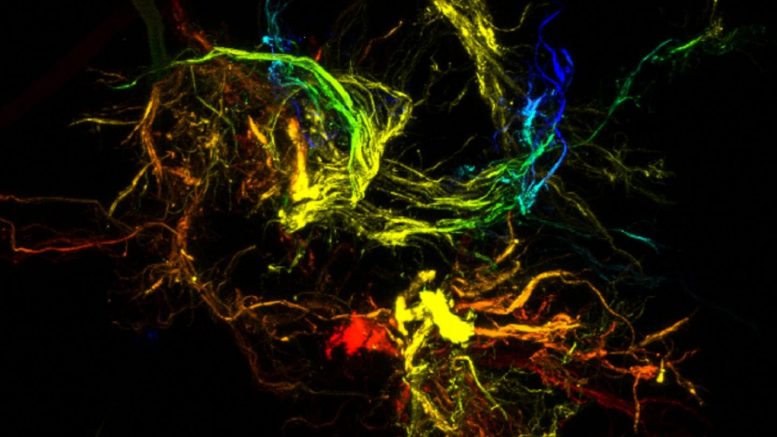
NC State researchers use a chaotic technique to create ordered particles with sticky properties. Credit: Orlin Velev, NC State University
New research from North Carolina State University shows that unique materials with distinct properties akin to those of gecko feet – the ability to stick to just about any surface – can be created by harnessing liquid-driven chaos to produce soft polymer microparticles with hierarchical branching on the micro- and nanoscale.
The findings, published today (October 14, 2019) in the journal Nature Materials, hold the potential for advances in gels, pastes, foods, nonwovens, and coatings, among other formulations.
The soft dendritic particle materials with unique adhesive and structure-building properties can be created from a variety of polymers precipitated from solutions under special conditions, says Orlin Velev, S. Frank and Doris Culberson Distinguished Professor of Chemical and Biomolecular Engineering at NC State and corresponding author of the paper.
“We use ‘liquid’ nanomanufacturing to convert most polymers into branched particles after dissolving the polymer and mixing the solution rapidly with another liquid,” he said. “This rapid mixing in turbulent flow creates branched particles organized in a hierarchical way.”
The thinnest branches surrounding these particles form a corona of nanofibers, Velev added, that distribute their stickiness by molecular forces of attraction known as van der Waals forces.
The new material is unique not only in its structure, but also in the way it is fabricated.
“The use of turbulent flow is ordinarily not known as a way to fabricate organized structures,” Velev said. “Here, we are using this inherently chaotic process to create hierarchical structures.”
The liquid process used to create these materials works with many types of polymers and is generally efficient and inexpensive. Velev added that the fabrication process can be easily scaled up to produce large amounts of the soft nanomaterial, which is often a challenge for making materials at the micro- and nanoscale.
Future research in Velev’s lab will seek to detail the fundamentals behind this surprising finding. Research will also examine the different types of polymer and biopolymer materials that can be created using the process, including coatings and sheets that attract or repel water, for example, or cell scaffolds and 3-D printing pastes. NC State has filed a patent on the new soft dendritic materials and the process for creating them.
“This work is an illustration of how fundamental and applied science can work synergistically,” said Simeon Stoyanov, a research collaborator and co-author of the paper. “We started with fundamental scientific findings and while investigating them we found many new applications such as super-adhesives and coatings, which in turn brought new fundamental questions regarding their properties.”
###
Former Ph.D. student Sangchul Roh is a co-inventor of the nanofabrication process and the first author of the paper, which is also co-authored by graduate students Austin Williams and Rachel Bang, who are continuing the investigation of the new material’s formation and applications.
The research is funded by the National Science Foundation under grants CMMI-1825476, CBET-1604116 and by NC State’s Chancellor’s Innovation Fund.
Reference: “Soft dendritic microparticles with unusual adhesion and structuring properties” by Sangchul Roh, Austin H. Williams, Rachel S. Bang, Simeon D. Stoyanov and Orlin D. Velev, 14 October 2019, Nature Materials.
DOI: 10.1038/s41563-019-0508-z
Abstract: The interplay between morphology, excluded volume and adhesivity of particles critically determines the physical properties of numerous soft materials and coatings. Branched particles or nanofibres, nanofibrillated cellulose or fumed silica can enhance the structure-building abilities of colloids, whose adhesion may also be increased by capillarity or binding agents. Nonetheless, alternative mechanisms of strong adhesion found in nature involve fibrillar mats with numerous subcontacts (contact splitting) as seen in the feet of gecko lizards and spider webs. Here, we describe the fabrication of hierarchically structured polymeric microparticles having branched nanofibre coronas with a dendritic morphology. Polymer precipitation in highly turbulent flow results in microparticles with fractal branching and nanofibrillar contact splitting that exhibit gelation at very low volume fractions, strong interparticle adhesion and binding into coatings and non-woven sheets. These soft dendritic particles also have potential advantages for food, personal care or pharmaceutical product formulations.

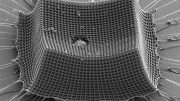
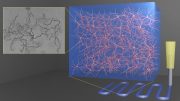
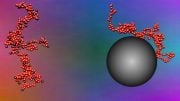

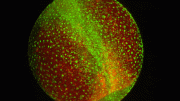
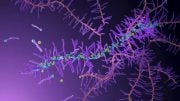
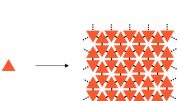
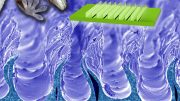
Be the first to comment on "Unique Particles – With Stickiness of Gecko Feet – Formed by Harnessing Chaos"